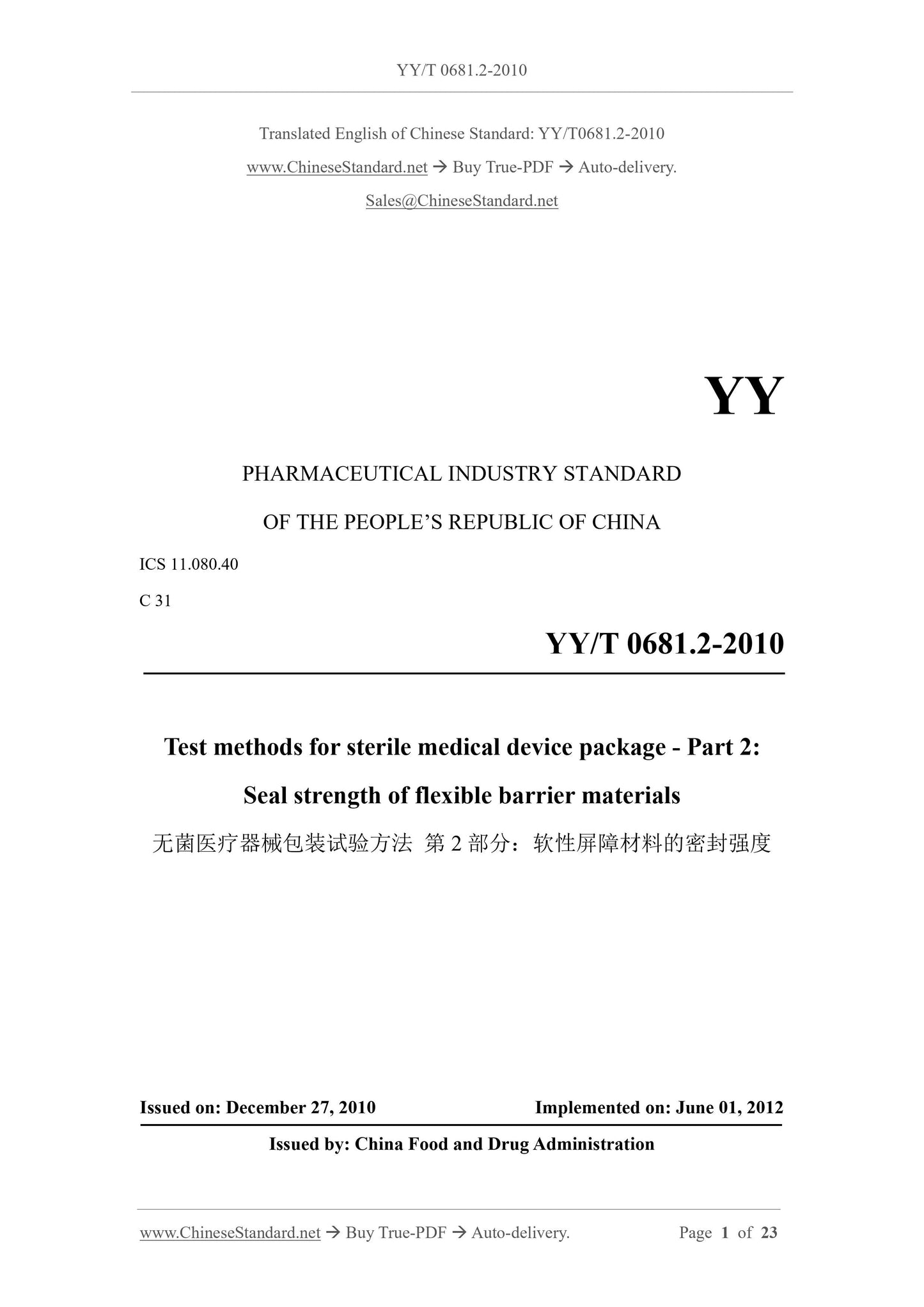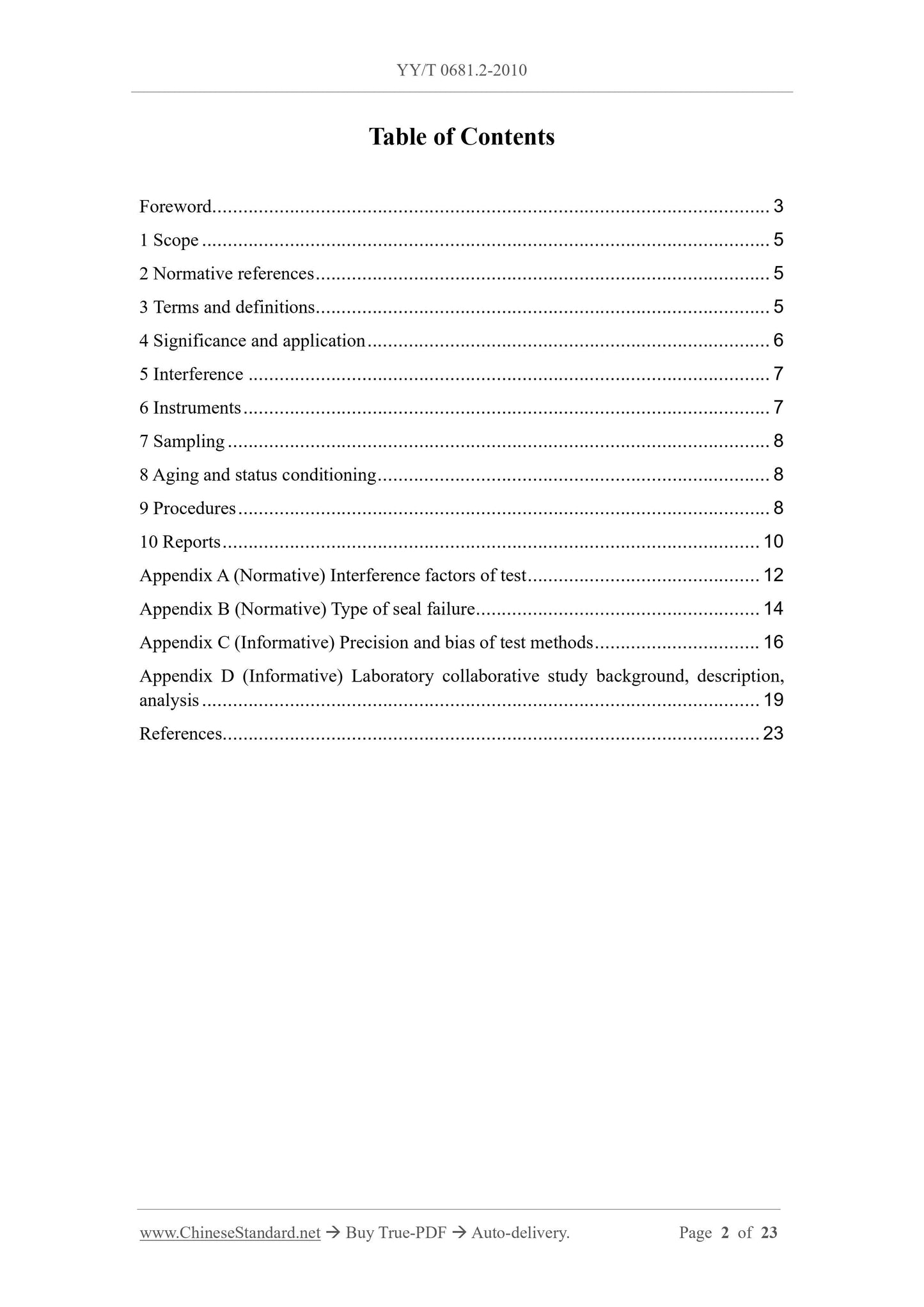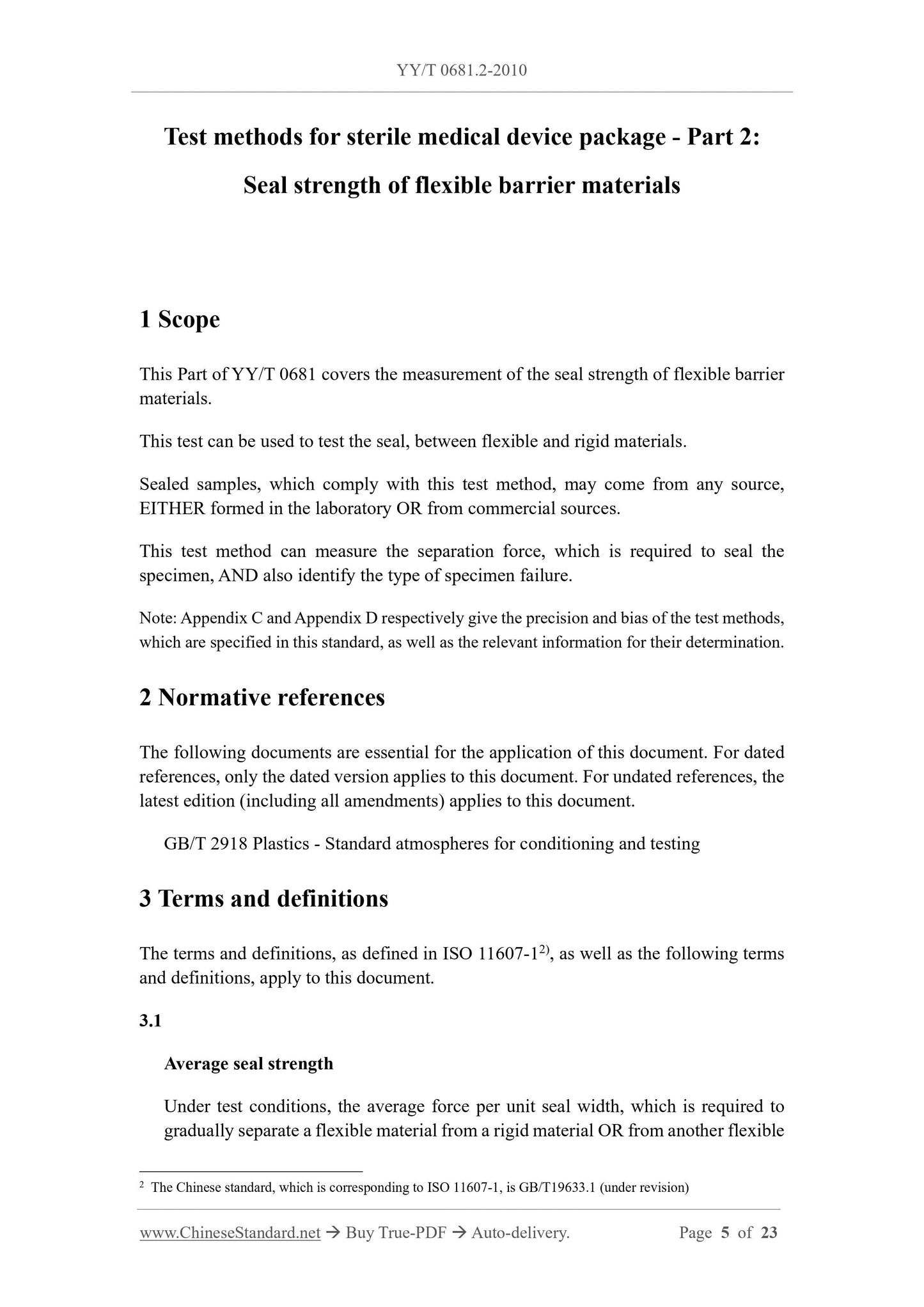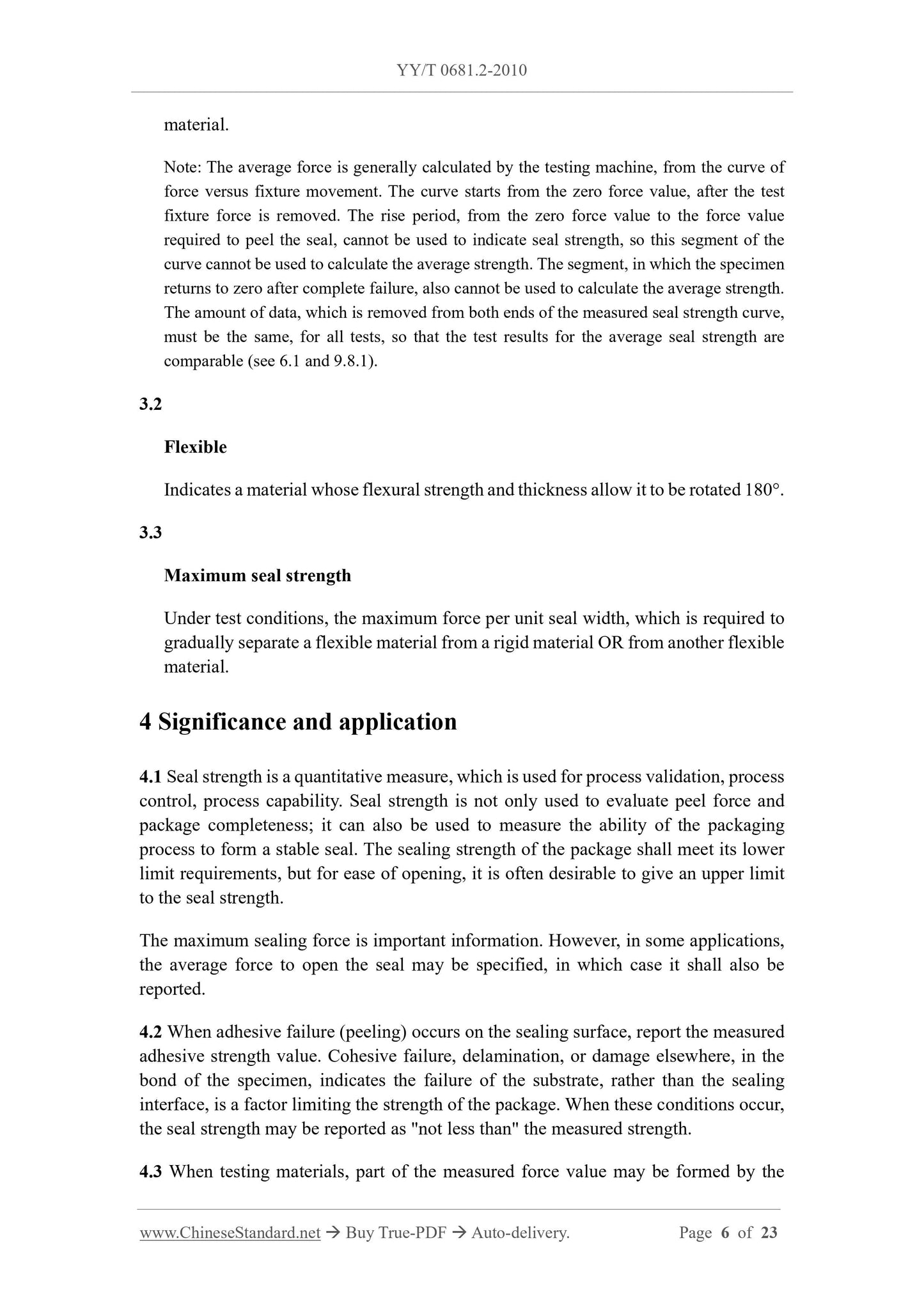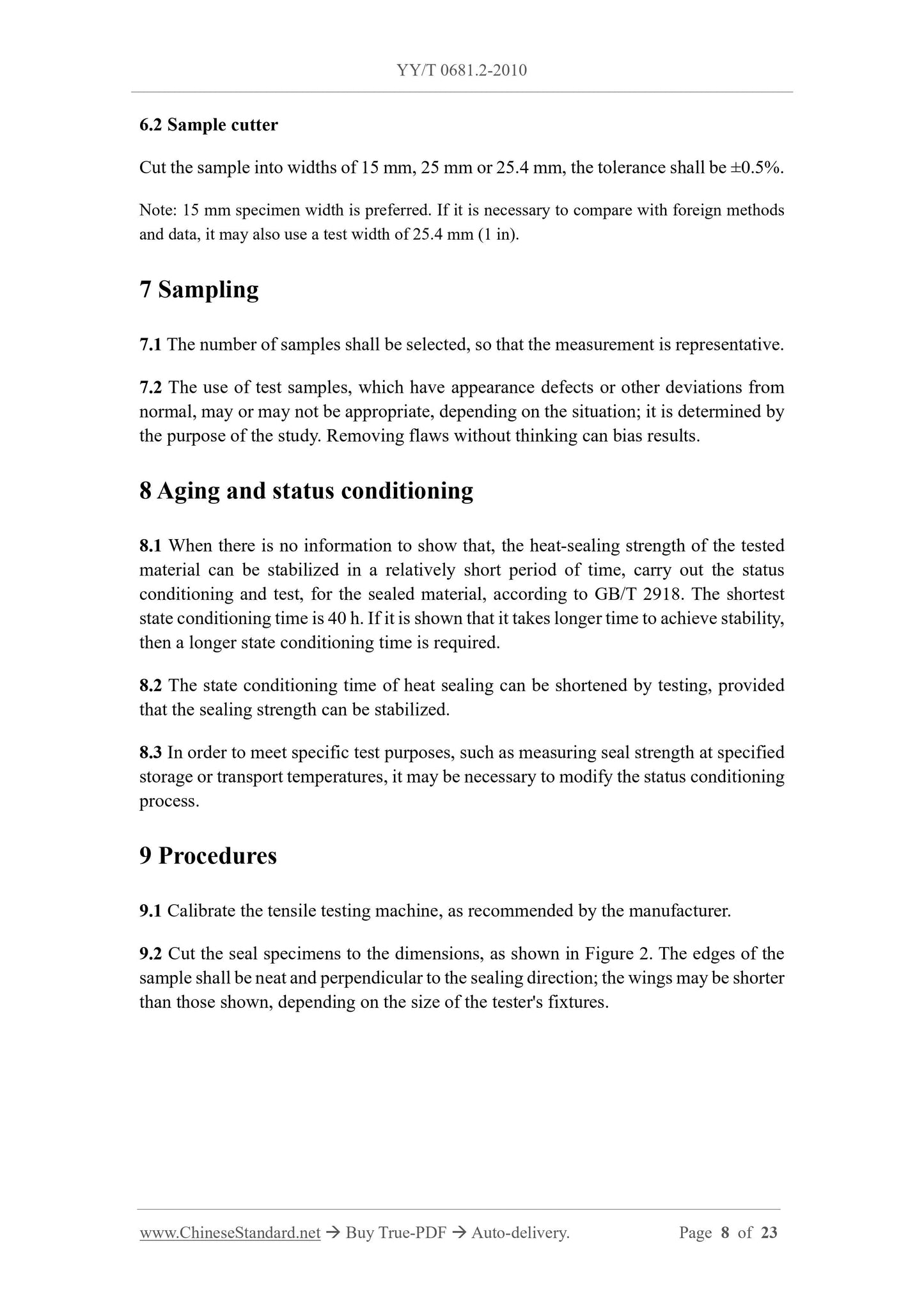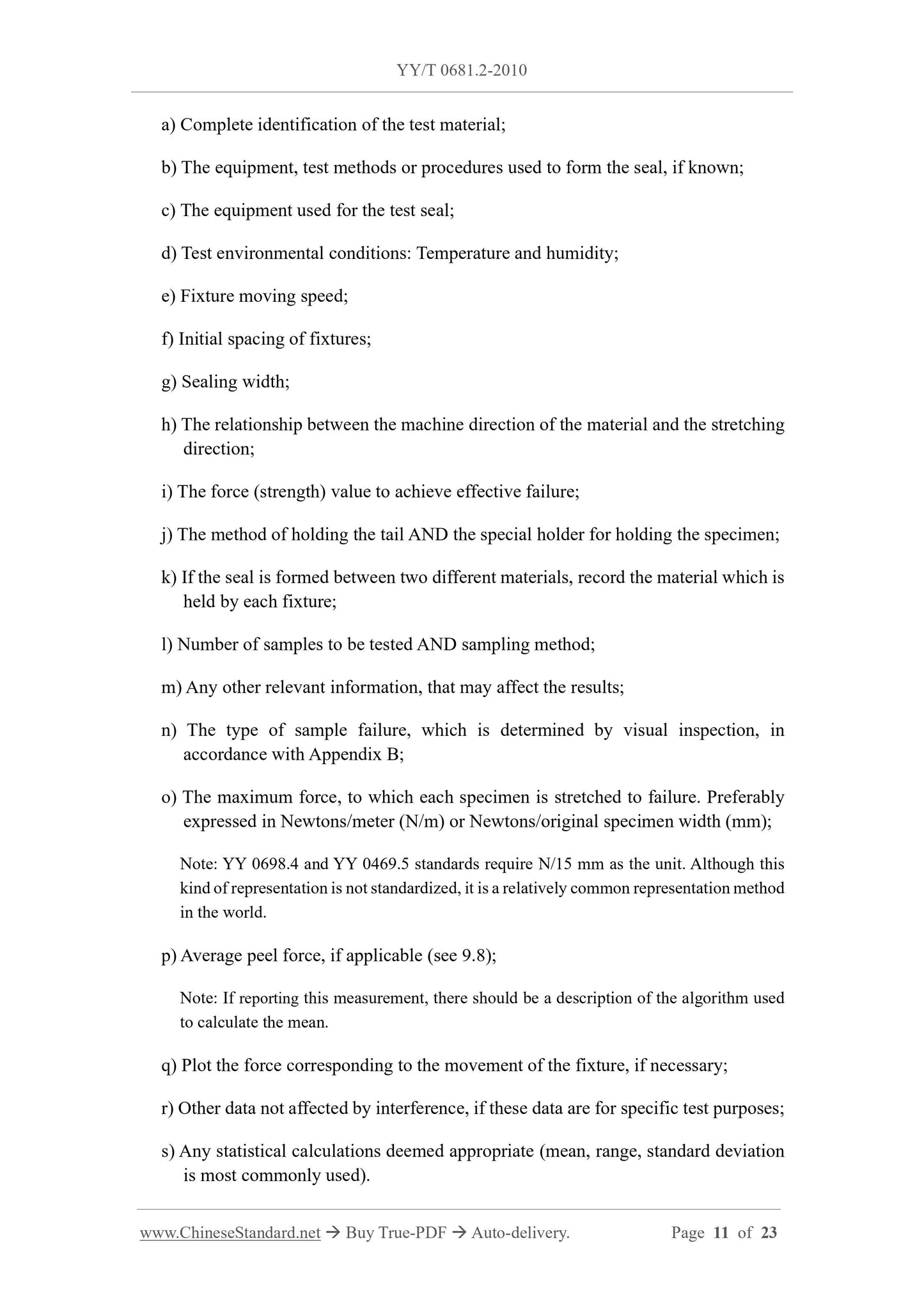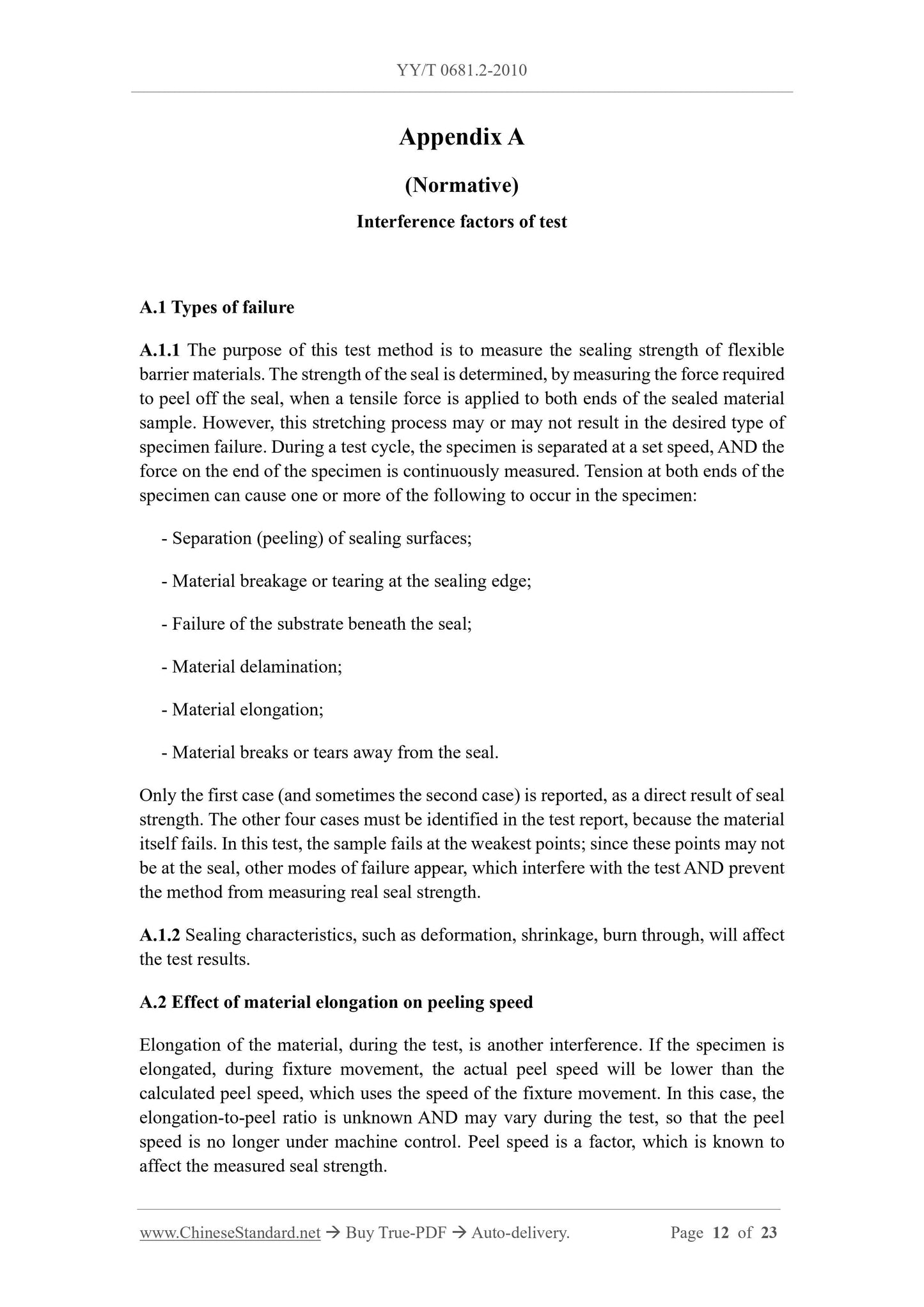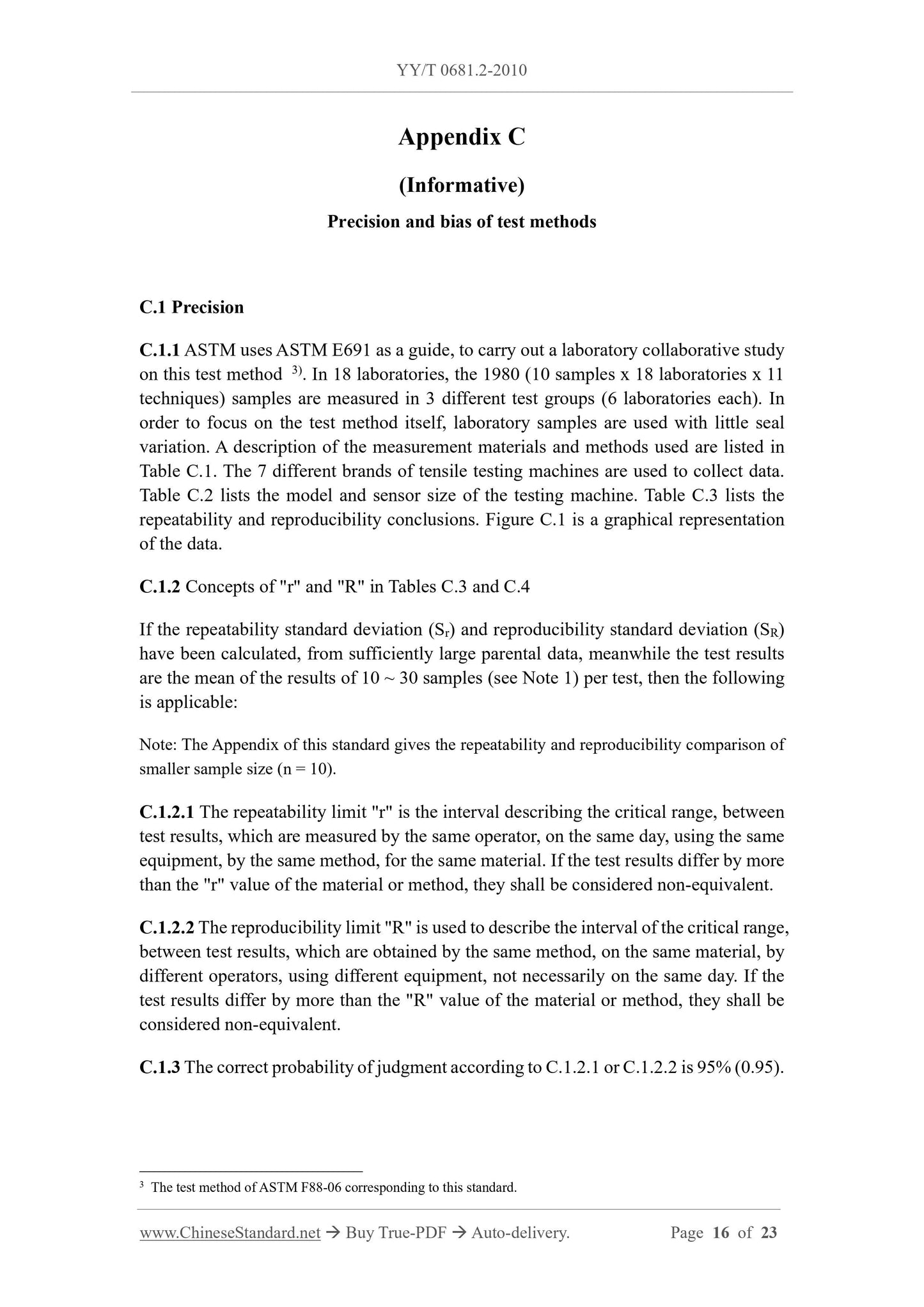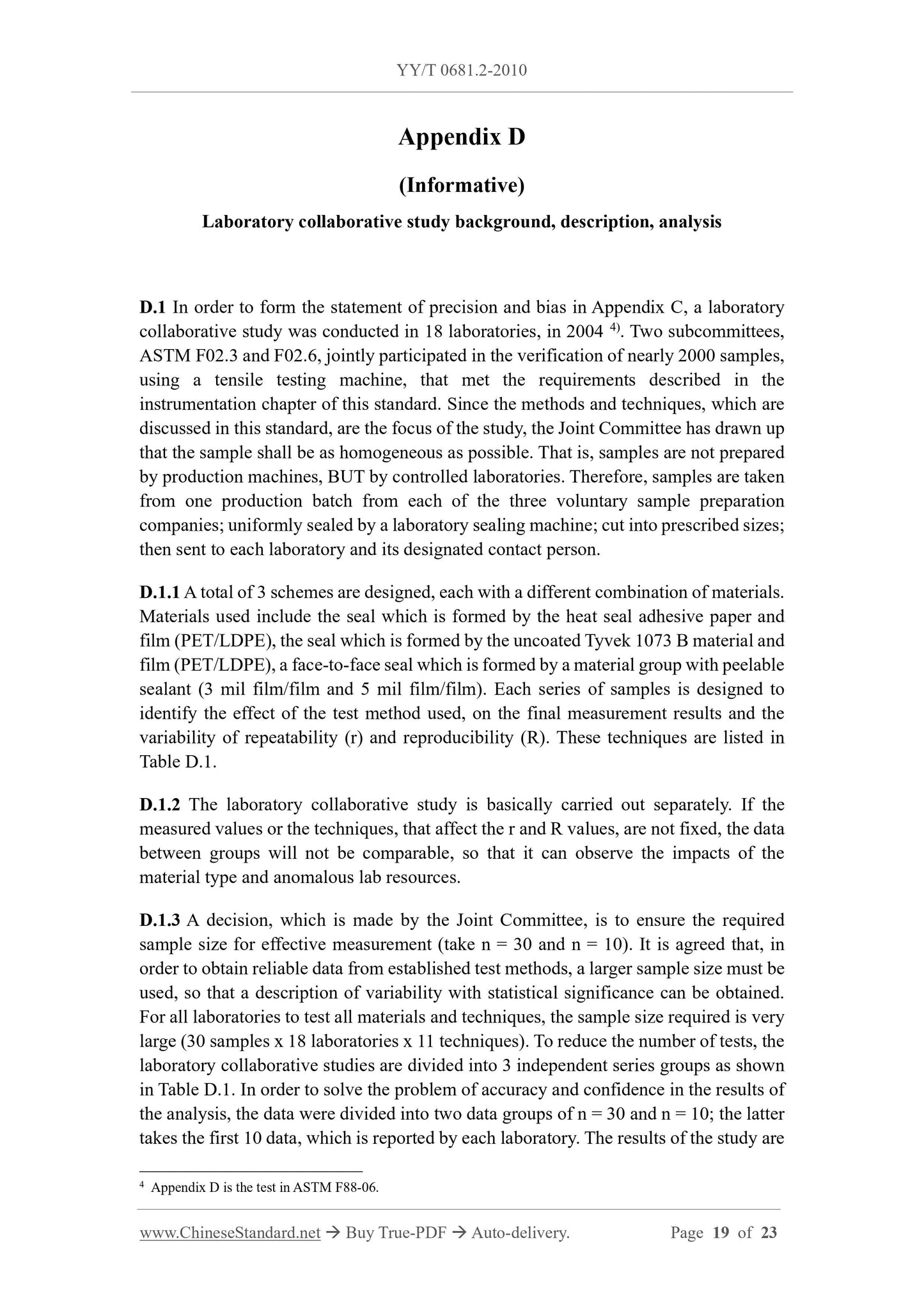1
/
of
9
PayPal, credit cards. Download editable-PDF and invoice in 1 second!
YY/T 0681.2-2010 English PDF (YYT0681.2-2010)
YY/T 0681.2-2010 English PDF (YYT0681.2-2010)
Regular price
$275.00 USD
Regular price
Sale price
$275.00 USD
Unit price
/
per
Shipping calculated at checkout.
Couldn't load pickup availability
Delivery: 3 seconds. Download true-PDF + Invoice.
Get QUOTATION in 1-minute: Click YY/T 0681.2-2010
Historical versions: YY/T 0681.2-2010
Preview True-PDF (Reload/Scroll if blank)
YY/T 0681.2-2010: Test methods for sterile medical device package. Part 2: Seal strength of flexible battier materials
YY/T 0681.2-2010
PHARMACEUTICAL INDUSTRY STANDARD
OF THE PEOPLE’S REPUBLIC OF CHINA
ICS 11.080.40
C 31
Test methods for sterile medical device package - Part 2:
Seal strength of flexible barrier materials
ISSUED ON: DECEMBER 27, 2010
IMPLEMENTED ON: JUNE 01, 2012
Issued by: China Food and Drug Administration
Table of Contents
Foreword ... 3
1 Scope ... 5
2 Normative references ... 5
3 Terms and definitions... 5
4 Significance and application ... 6
5 Interference ... 7
6 Instruments ... 7
7 Sampling ... 8
8 Aging and status conditioning ... 8
9 Procedures ... 8
10 Reports ... 10
Appendix A (Normative) Interference factors of test ... 12
Appendix B (Normative) Type of seal failure ... 14
Appendix C (Informative) Precision and bias of test methods ... 16
Appendix D (Informative) Laboratory collaborative study background, description,
analysis ... 19
References ... 23
Test methods for sterile medical device package - Part 2:
Seal strength of flexible barrier materials
1 Scope
This Part of YY/T 0681 covers the measurement of the seal strength of flexible barrier
materials.
This test can be used to test the seal, between flexible and rigid materials.
Sealed samples, which comply with this test method, may come from any source,
EITHER formed in the laboratory OR from commercial sources.
This test method can measure the separation force, which is required to seal the
specimen, AND also identify the type of specimen failure.
Note: Appendix C and Appendix D respectively give the precision and bias of the test methods,
which are specified in this standard, as well as the relevant information for their determination.
2 Normative references
The following documents are essential for the application of this document. For dated
references, only the dated version applies to this document. For undated references, the
latest edition (including all amendments) applies to this document.
GB/T 2918 Plastics - Standard atmospheres for conditioning and testing
3 Terms and definitions
The terms and definitions, as defined in ISO 11607-12), as well as the following terms
and definitions, apply to this document.
3.1
Average seal strength
Under test conditions, the average force per unit seal width, which is required to
gradually separate a flexible material from a rigid material OR from another flexible
2 The Chinese standard, which is corresponding to ISO 11607-1, is GB/T19633.1 (under revision)
material.
Note: The average force is generally calculated by the testing machine, from the curve of
force versus fixture movement. The curve starts from the zero force value, after the test
fixture force is removed. The rise period, from the zero force value to the force value
required to peel the seal, cannot be used to indicate seal strength, so this segment of the
curve cannot be used to calculate the average strength. The segment, in which the specimen
returns to zero after complete failure, also cannot be used to calculate the average strength.
The amount of data, which is removed from both ends of the measured seal strength curve,
must be the same, for all tests, so that the test results for the average seal strength are
comparable (see 6.1 and 9.8.1).
3.2
Flexible
Indicates a material whose flexural strength and thickness allow it to be rotated 180°.
3.3
Maximum seal strength
Under test conditions, the maximum force per unit seal width, which is required to
gradually separate a flexible material from a rigid material OR from another flexible
material.
4 Significance and application
4.1 Seal strength is a quantitative measure, which is used for process validation, process
control, process capability. Seal strength is not only used to evaluate peel force and
package completeness; it can also be used to measure the ability of the packaging
process to form a stable seal. The sealing strength of the package shall meet its lower
limit requirements, but for ease of opening, it is often desirable to give an upper limit
to the seal strength.
The maximum sealing force is important information. However, in some applications,
the average force to open the seal may be specified, in which case it shall also be
reported.
4.2 When adhesive failure (peeling) occurs on the sealing surface, report the measured
adhesive strength value. Cohesive failure, delamination, or damage elsewhere, in the
bond of the specimen, indicates the failure of the substrate, rather than the sealing
interface, is a factor limiting the strength of the package. When these conditions occur,
the seal strength may be reported as "not less than" the measured strength.
4.3 When testing materials, part of the measured force value may be formed by the
6.2 Sample cutter
Cut the sample into widths of 15 mm, 25 mm or 25.4 mm, the tolerance shall be ±0.5%.
Note: 15 mm specimen width is preferred. If it is necessary to compare with foreign methods
and data, it may also use a test width of 25.4 mm (1 in).
7 Sampling
7.1 The number of samples shall be selected, so that the measurement is representative.
7.2 The use of test samples, which have appearance defects or other deviations from
normal, may or may not be appropriate, depending on the situation; it is determined by
the purpose of the study. Removing flaws without thinking can bias results.
8 Aging and status conditioning
8.1 When there is no information to show that, the heat-sealing strength of the tested
material can be stabilized in a relatively short period of time, carry out the status
conditioning and test, for the sealed material, according to GB/T 2918. The shortest
state conditioning time is 40 h. If it is shown that it takes longer time to achieve stability,
then a longer state conditioning time is required.
8.2 The state conditioning time of heat sealing can be shortened by testing, provided
that the sealing strength can be stabilized.
8.3 In order to meet specific test purposes, such as measuring seal strength at specified
storage or transport temperatures, it may be necessary to modify the status conditioning
process.
9 Procedures
9.1 Calibrate the tensile testing machine, as recommended by the manufacturer.
9.2 Cut the seal specimens to the dimensions, as shown in Figure 2. The edges of the
sample shall be neat and perpendicular to the sealing direction; the wings may be shorter
than those shown, depending on the size of the tester's fixtures.
a) Complete identification of the test material;
b) The equipment, test methods or procedures used to form the seal, if known;
c) The equipment used for the test seal;
d) Test environmental conditions: Temperature and humidity;
e) Fixture moving speed;
f) Initial spacing of fixtures;
g) Sealing width;
h) The relationship between the machine direction of the material and the stretching
direction;
i) The force (strength) value to achieve effective failure;
j) The method of holding the tail AND the special holder for holding the specimen;
k) If the seal is formed between two different materials, record the material which is
held by each fixture;
l) Number of samples to be tested AND sampling method;
m) Any other relevant information, that may affect the results;
n) The type of sample failure, which is determined by visual inspection, in
accordance with Appendix B;
o) The maximum force, to which each specimen is stretched to failure. Preferably
expressed in Newtons/meter (N/...
Get QUOTATION in 1-minute: Click YY/T 0681.2-2010
Historical versions: YY/T 0681.2-2010
Preview True-PDF (Reload/Scroll if blank)
YY/T 0681.2-2010: Test methods for sterile medical device package. Part 2: Seal strength of flexible battier materials
YY/T 0681.2-2010
PHARMACEUTICAL INDUSTRY STANDARD
OF THE PEOPLE’S REPUBLIC OF CHINA
ICS 11.080.40
C 31
Test methods for sterile medical device package - Part 2:
Seal strength of flexible barrier materials
ISSUED ON: DECEMBER 27, 2010
IMPLEMENTED ON: JUNE 01, 2012
Issued by: China Food and Drug Administration
Table of Contents
Foreword ... 3
1 Scope ... 5
2 Normative references ... 5
3 Terms and definitions... 5
4 Significance and application ... 6
5 Interference ... 7
6 Instruments ... 7
7 Sampling ... 8
8 Aging and status conditioning ... 8
9 Procedures ... 8
10 Reports ... 10
Appendix A (Normative) Interference factors of test ... 12
Appendix B (Normative) Type of seal failure ... 14
Appendix C (Informative) Precision and bias of test methods ... 16
Appendix D (Informative) Laboratory collaborative study background, description,
analysis ... 19
References ... 23
Test methods for sterile medical device package - Part 2:
Seal strength of flexible barrier materials
1 Scope
This Part of YY/T 0681 covers the measurement of the seal strength of flexible barrier
materials.
This test can be used to test the seal, between flexible and rigid materials.
Sealed samples, which comply with this test method, may come from any source,
EITHER formed in the laboratory OR from commercial sources.
This test method can measure the separation force, which is required to seal the
specimen, AND also identify the type of specimen failure.
Note: Appendix C and Appendix D respectively give the precision and bias of the test methods,
which are specified in this standard, as well as the relevant information for their determination.
2 Normative references
The following documents are essential for the application of this document. For dated
references, only the dated version applies to this document. For undated references, the
latest edition (including all amendments) applies to this document.
GB/T 2918 Plastics - Standard atmospheres for conditioning and testing
3 Terms and definitions
The terms and definitions, as defined in ISO 11607-12), as well as the following terms
and definitions, apply to this document.
3.1
Average seal strength
Under test conditions, the average force per unit seal width, which is required to
gradually separate a flexible material from a rigid material OR from another flexible
2 The Chinese standard, which is corresponding to ISO 11607-1, is GB/T19633.1 (under revision)
material.
Note: The average force is generally calculated by the testing machine, from the curve of
force versus fixture movement. The curve starts from the zero force value, after the test
fixture force is removed. The rise period, from the zero force value to the force value
required to peel the seal, cannot be used to indicate seal strength, so this segment of the
curve cannot be used to calculate the average strength. The segment, in which the specimen
returns to zero after complete failure, also cannot be used to calculate the average strength.
The amount of data, which is removed from both ends of the measured seal strength curve,
must be the same, for all tests, so that the test results for the average seal strength are
comparable (see 6.1 and 9.8.1).
3.2
Flexible
Indicates a material whose flexural strength and thickness allow it to be rotated 180°.
3.3
Maximum seal strength
Under test conditions, the maximum force per unit seal width, which is required to
gradually separate a flexible material from a rigid material OR from another flexible
material.
4 Significance and application
4.1 Seal strength is a quantitative measure, which is used for process validation, process
control, process capability. Seal strength is not only used to evaluate peel force and
package completeness; it can also be used to measure the ability of the packaging
process to form a stable seal. The sealing strength of the package shall meet its lower
limit requirements, but for ease of opening, it is often desirable to give an upper limit
to the seal strength.
The maximum sealing force is important information. However, in some applications,
the average force to open the seal may be specified, in which case it shall also be
reported.
4.2 When adhesive failure (peeling) occurs on the sealing surface, report the measured
adhesive strength value. Cohesive failure, delamination, or damage elsewhere, in the
bond of the specimen, indicates the failure of the substrate, rather than the sealing
interface, is a factor limiting the strength of the package. When these conditions occur,
the seal strength may be reported as "not less than" the measured strength.
4.3 When testing materials, part of the measured force value may be formed by the
6.2 Sample cutter
Cut the sample into widths of 15 mm, 25 mm or 25.4 mm, the tolerance shall be ±0.5%.
Note: 15 mm specimen width is preferred. If it is necessary to compare with foreign methods
and data, it may also use a test width of 25.4 mm (1 in).
7 Sampling
7.1 The number of samples shall be selected, so that the measurement is representative.
7.2 The use of test samples, which have appearance defects or other deviations from
normal, may or may not be appropriate, depending on the situation; it is determined by
the purpose of the study. Removing flaws without thinking can bias results.
8 Aging and status conditioning
8.1 When there is no information to show that, the heat-sealing strength of the tested
material can be stabilized in a relatively short period of time, carry out the status
conditioning and test, for the sealed material, according to GB/T 2918. The shortest
state conditioning time is 40 h. If it is shown that it takes longer time to achieve stability,
then a longer state conditioning time is required.
8.2 The state conditioning time of heat sealing can be shortened by testing, provided
that the sealing strength can be stabilized.
8.3 In order to meet specific test purposes, such as measuring seal strength at specified
storage or transport temperatures, it may be necessary to modify the status conditioning
process.
9 Procedures
9.1 Calibrate the tensile testing machine, as recommended by the manufacturer.
9.2 Cut the seal specimens to the dimensions, as shown in Figure 2. The edges of the
sample shall be neat and perpendicular to the sealing direction; the wings may be shorter
than those shown, depending on the size of the tester's fixtures.
a) Complete identification of the test material;
b) The equipment, test methods or procedures used to form the seal, if known;
c) The equipment used for the test seal;
d) Test environmental conditions: Temperature and humidity;
e) Fixture moving speed;
f) Initial spacing of fixtures;
g) Sealing width;
h) The relationship between the machine direction of the material and the stretching
direction;
i) The force (strength) value to achieve effective failure;
j) The method of holding the tail AND the special holder for holding the specimen;
k) If the seal is formed between two different materials, record the material which is
held by each fixture;
l) Number of samples to be tested AND sampling method;
m) Any other relevant information, that may affect the results;
n) The type of sample failure, which is determined by visual inspection, in
accordance with Appendix B;
o) The maximum force, to which each specimen is stretched to failure. Preferably
expressed in Newtons/meter (N/...
Share
